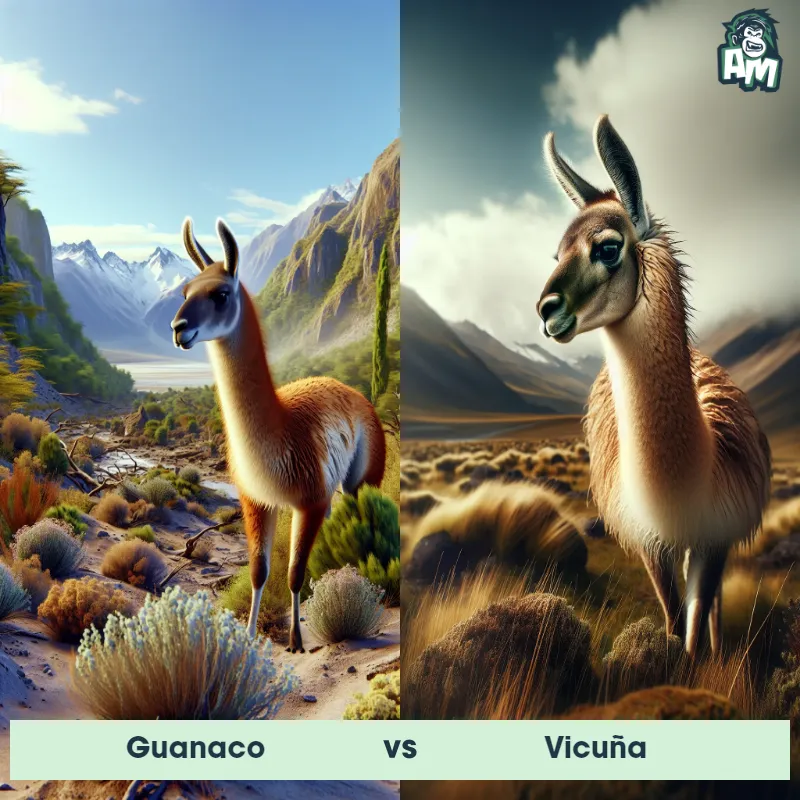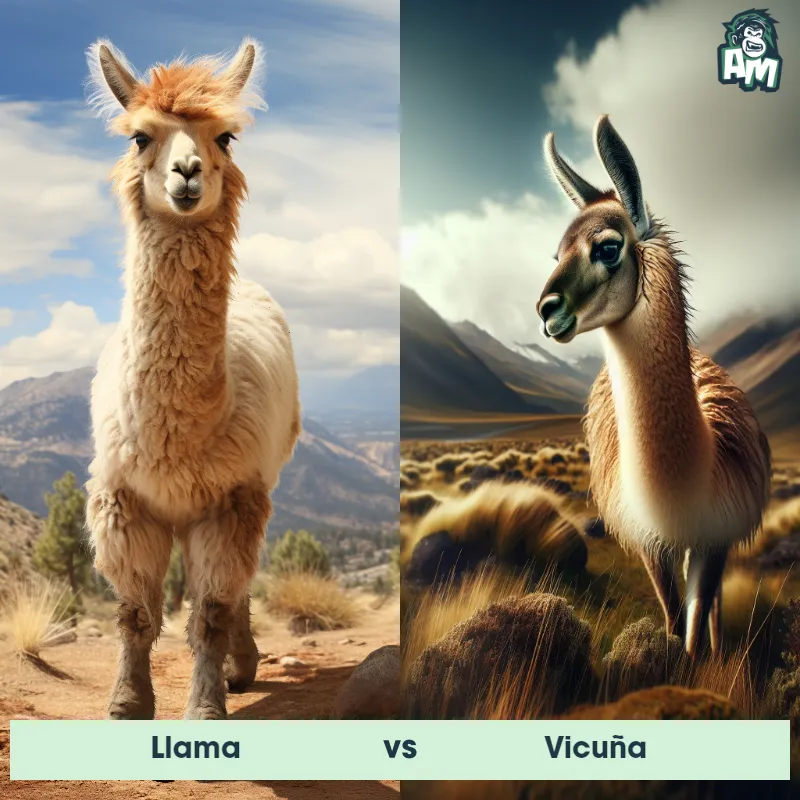The Vicuña
The Vicuña, also known as Vicugna vicugna, is a small camelid native to the high altitudes of the Andes Mountains in South America. They are the smallest member of the camel family and are highly adapted to living in harsh, cold, and arid environments. Vicuñas have a slender body with long legs and a small head. Their fur is soft, fine, and dense, ranging in color from light brown to reddish-brown. They have a white chest and a white face with a dark-colored muzzle. Vicuñas have large, expressive eyes and long, lustrous eyelashes. They weigh around 90 to 140 pounds and can grow up to three feet tall at the shoulder. These animals have excellent eyesight and hearing, allowing them to detect predators from afar. They live in herds and feed mainly on grasses and other vegetation.

| Vicuña | |
|---|---|
| Size | 36 to 52 inches (91 to 132 cm) at the shoulder |
| Weight | 88 to 143 pounds (40 to 65 kg) |
| Speed | 35mph (56km/h) |
| Key Strength | Agility and speed |
| Biggest Weakness | Lack of physical aggression |
| Scientific Name | Vicugna vicugna |
| Family | Camelidae |
| Habitat | High alpine regions |
| Geography | Andes Mountains in South America |
| Diet | Grasses, shrubs, and other plant matter |
| Lifespan | 10 years - 15 years |

The Vicuña
The Vicuña, also known as Vicugna vicugna, is a small camelid native to the high altitudes of the Andes Mountains in South America. They are the smallest member of the camel family and are highly adapted to living in harsh, cold, and arid environments. Vicuñas have a slender body with long legs and a small head. Their fur is soft, fine, and dense, ranging in color from light brown to reddish-brown. They have a white chest and a white face with a dark-colored muzzle. Vicuñas have large, expressive eyes and long, lustrous eyelashes. They weigh around 90 to 140 pounds and can grow up to three feet tall at the shoulder. These animals have excellent eyesight and hearing, allowing them to detect predators from afar. They live in herds and feed mainly on grasses and other vegetation.
Fun Fact: The Vicuña is known for its exceptionally fine and valuable wool, which is considered one of the most luxurious and expensive fibers in the world. The wool is highly sought after for its softness, warmth, and hypoallergenic properties.
| Vicuña | |
|---|---|
| Size | 36 to 52 inches (91 to 132 cm) at the shoulder |
| Weight | 88 to 143 pounds (40 to 65 kg) |
| Speed | 35mph (56km/h) |
| Key Strength | Agility and speed |
| Biggest Weakness | Lack of physical aggression |
| Scientific Name | Vicugna vicugna |
| Family | Camelidae |
| Habitat | High alpine regions |
| Geography | Andes Mountains in South America |
| Diet | Grasses, shrubs, and other plant matter |
| Lifespan | 10 years - 15 years |
Vicuña Matchups
We use AI to simulate matchups between the Vicuña and other animals. Our simulation considers size, strength, and natural predatory behaviors to determine the most likely outcome.
Vicuña: Diet, Predators, Aggression, and Defensive Behaviors
What do Vicuñas eat?
Vicuñas are herbivores that primarily feed on grasses, herbs, and shrubs found in the high-altitude grasslands of the Andes Mountains. They are known to have a selective diet, choosing only the most nutritious and tender plant parts to consume. Due to the harsh environment they inhabit, vicuñas have evolved to efficiently extract nutrients from low-quality forage.
Do Vicuñas have any predators?
Vicuñas have natural predators such as mountain lions, foxes, and Andean condors. However, their keen senses of hearing and sight, as well as their agile and swift movements, help them evade predators in the open terrain of the Andes. Vicuñas often form groups that allow them to keep a lookout for potential threats while they graze.
Are Vicuñas aggressive?
Vicuñas are generally peaceful and social animals that live in herds, with strong bonds between family members. They do not exhibit aggressive behavior towards each other or other species. In fact, they are known for their timid nature and will usually flee from any perceived danger rather than confront it.
Do Vicuñas fight?
While vicuñas do not engage in aggressive confrontations with each other, dominant males may sometimes engage in brief sparring matches during the breeding season to establish their hierarchy within the herd. These fights are usually ritualistic and rarely result in serious injuries, as the goal is to assert dominance rather than cause harm.
How do Vicuñas defend themselves?
When faced with potential threats, vicuñas rely on their speed and agility to evade predators. Their keen senses of hearing and sight help them detect danger from a distance, allowing them to quickly flee to safety. Vicuñas are also known to emit alarm calls to alert others in the herd of impending danger.
What is the biggest weakness of Vicuñas in a fight?
Despite their ability to evade predators through speed and agility, vicuñas are relatively small and lack physical strength compared to larger predators such as mountain lions. Their primary defense mechanism is to flee rather than engage in physical combat, making them vulnerable to attacks if caught off guard. Additionally, their herding behavior can sometimes work against them, as predators may target isolated individuals that stray from the safety of the group.
Fun Fact: Unlike their wild relatives, Vicuñas cannot be domesticated due to their wild nature and strong flight behavior. They are extremely agile and can run at speeds of up to 50 miles per hour, making them one of the fastest land animals in South America.
Fun Fact: Vicuñas have a unique adaptation called "thermoregulation," allowing them to withstand extreme temperature variations in their habitat. They can tolerate temperatures as low as -22°F -30°C during the night, while their thick fur provides insulation against the scorching sun in high-altitude areas, where temperatures can reach 95°F 35°C during the day. This remarkable adaptation helps them survive in the challenging climate of the Andes.













